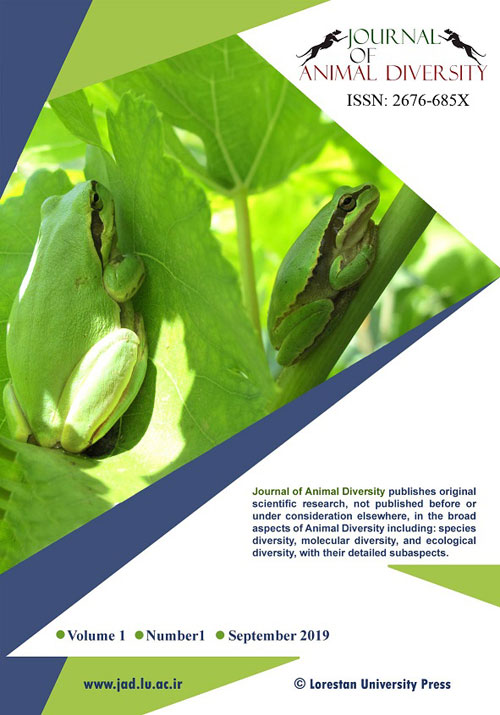فهرست مطالب

Journal of Animal Diversity
Volume:1 Issue: 1, Sep 2019
- تاریخ انتشار: 1398/06/10
- تعداد عناوین: 6
-
Pages 1-10
The number of exotic freshwater ornamental fish species released from the aquarium trade in Iran has been increasing in recent years. All recorded exotic aquarium fishes are listed here, including 8 species in 7 genera, 5 families, and 5 orders. The introduced species belong to the Neotropical, Nearctic and Palearctic fish elements. Their distribution ranges within Iranian freshwater ecosystems are given, and the presence of Koi (ornamental Cyprinus carpio) are recorded for the first time from Iranian inland waters. Eradication programs need to be accompanied by a public awareness campaign to ensure that the aquarium trade and hobbyists do not release these pet fishes into natural habitats.
Keywords: Aquarium trade, exotic fish, alien species, Neotropical, Nearctic, Palearctic -
Pages 11-19
In the present study, we studied the development and morphology of different larval stages of Pelophylax bedriagae (Camerano) at two rearing temperatures (20 and 24 °C). Eggs were collected from a breeding site in western Iran. Diagnostic morphological characters are provided for Gosner (1960) larval stages 1–46. The larvae hatched about seven days after egg deposition in the laboratory. A principal diagnostic feature, the formation of the funnel-shaped oral disc, became discernible about ten days after hatching at Gosner stage 21 and degenerated at Gosner stage 42. Based on our results, the longest metamorphosis time was observed at 20 °C whilst the shortest metamorphosis time occurred at 24 °C. The largest body length of larval P. bedriagae measured about 54 mm in 70 days after egg deposition. Compared with the majority of other Palearctic anurans, it appears that embryonic and larval development is usually slow in P. bedriagae.
Keywords: Development, larval stages, Pelophylax bedriagae, temperatures -
Pages 20-25
Herpetology in Iran is alive and well and experiencing an unprecedented period of productivity. Consequently, in recent years there have been several books dealing with the reptiles of Iran. Among these are works by Rastegar-Pouyani et al. (2007), Kamali (2017) and Rajabizadeh (2018). Although each of these makes a valuable contribution, these books were published in Farsi only, limiting their usefulness to those outside of Iran. ...
Keywords: Herpetology, lizard, snakes, Iran -
Pages 26-33
Over the past decades, zoos and aquaria have shifted from an emphasis on ex situ conservation of animal species to strategies that emphasize educative and fund-raising efforts to halt environmental degradation ‘in situ’. However, it is here proposed that ‘ex situ’ breeding programs have a strong educative potential and if they are coupled with a fine-grain taxonomy based on phylogenetic thinking, they can be perceived as a strong ethical message against homogenization of global biodiversity to be directed at global, national and local levels.
Keywords: Zoos, phylogenetic systematics, local populations, evolutionary history, ‘ex situ’ conservation, endemism, tourism -
Pages 34-40
Passeromyia is a genus of flies associated with birds’ nests. Adults of Passeromyia heterochaeta were found within the houses near to domestic pigeon nests in Lorestan Province, western Iran. Flies were identified at the genus level by analysis of COI sequences of a representative specimen. Then, the specimens were identified according to morphological characteristics as P. heterochaeta and the sequence was submitted to the GenBank under this name. DNA barcoding approach can be used for approximate identification before using morphological keys.
Keywords: Bird myiasis, COI barcoding, phylogenetic tree, Lorestan Province -
Pages 41-55
Behavioral events of two raptor species, the White-bellied Sea Eagle, Haliaeetus leucogaster Gmelin, 1788 and Brahminy Kite, Haliastur indus Boddaert, 1783 were studied once every two weeks in two locations in northwestern Malaysia, namely Balik Pulau and Kuala Sepetang, from September 2012 to September 2013. The average total number of behavioral events per hour was 45.9 (±40.3 SD), 117.0 (±131.7 SD), and 285.8 (±185.0 SD) for H. leucogaster at Balik Pulau, and H. indus at Balik Pulau and Kuala Sepetang, respectively. The total number of individuals of each species observed was significantly influenced by the time of day and weather (p<0.05). It was observed that the percentage of time spent for perching, flying, hunting and competition was significantly different between these two species and between two locations. The total number of behavioral events during observation dates was no different for the White-bellied Sea Eagle than that of the Brahminy Kite. Overall, the percentage of time that the birds spent perching, flying, hunting, social behavior and competition was different between species. The highest rate of successful predation was 94.6% for H. leucogaster while it was lower for H. indus at Balik Pulau (72.8%). The time of day was an effective factor for determining behaviors of H. leucogaster while it was not significant for H. indus. The effect of boat numbers and weather on behavior varied between species and locations. The state of the tide and the number of crows present did not have any significant effect on activities of these two species. Results of the comparison of the percentage of occurrence of five types of behavior between adults and juveniles showed that behaviors of perching, hunting and social behavior were different for H. leucogaster, behaviors of perching, flying and social interaction for H. indus at Balik Pulau and behaviors of perching, flying, hunting and social interaction for H. indus at Kuala Sepetang. However, they did not show different behavioral events of involving competition.
Keywords: Behavior, Brahminy Kite, White-bellied Sea Eagle, Malaysia

